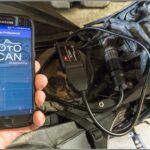An Obdii Drive Cycle is a standardized procedure that your vehicle performs to verify the functionality of its emission control systems. Completing an OBDII drive cycle is often necessary to reset the “readiness monitors” after you’ve cleared diagnostic trouble codes or disconnected the car battery. These monitors need to be in a “ready” state to pass an emissions test. This guide provides a step-by-step process for performing a General Motors (GM) OBDII drive cycle.
Steps to Perform a GM OBDII Drive Cycle
Follow these steps carefully to ensure all necessary emission monitors are tested and set to “ready”.
-
Cold Start:
Begin with a cold start. This means the engine coolant temperature must be below 122°F (50°C) and within 11°F (6°C) of the ambient air temperature when you start the engine. Ensure the key is not in the ignition prior to starting, as this could prevent the heated oxygen sensor diagnostic from running correctly. -
Idle with Load:
Start the engine and let it idle for two and a half minutes. During this idle period, turn on the air conditioner to maximum and activate the rear defroster. Adding electrical load helps to test systems like the O2 sensor heater, passive air injection system, and the purge valve “no flow” condition. It also allows for misfire detection and, if the system enters closed loop operation, fuel trim adjustments to be evaluated. -
Moderate Acceleration:
Turn off the air conditioner and rear defroster, and any other electrical loads. Accelerate smoothly to 55 mph (88 km/h) using about half throttle. This acceleration phase is crucial for testing the misfire detection system, fuel trim accuracy, and purge flow of the evaporative emissions system. -
Maintain Steady Speed:
Hold a constant speed of 55 mph (88 km/h) for three minutes. During this steady cruise, several critical emission monitors are evaluated, including the O2 sensor response time, intrusive air system (if equipped), EGR (Exhaust Gas Recirculation) system function, purge flow, misfire detection, and fuel trim adjustments. -
Deceleration (Coast Down):
Release the accelerator pedal completely and allow the vehicle to coast down to 20 mph (32 km/h). It’s important not to apply the brakes, shift gears (for manual transmissions, leave it in gear), or depress the clutch pedal during deceleration. This coast-down phase tests the EGR system, purge valve operation, and fuel trim under deceleration conditions. -
Accelerate to Highway Speed:
Accelerate again, this time using approximately 3/4 throttle, until you reach a speed between 55-60 mph (88-96 km/h). This step repeats the diagnostics performed during the initial acceleration phase, further ensuring the robustness of the misfire, fuel trim, and purge flow diagnostics. -
Extended Steady Speed:
Maintain a steady speed of 55 mph (88 km/h) for a longer duration of five minutes. This extended cruise period is essential for running the catalyst monitor diagnostic, which assesses the efficiency of your catalytic converter. If the catalyst is marginal or if the battery has recently been disconnected, it might take up to five complete drive cycles for the catalyst monitor to complete and set to “ready”. -
Final Deceleration:
Perform a final deceleration similar to step 5. Release the accelerator pedal and coast down to 20 mph (32 km/h) without using the brakes, clutch, or shifting gears. This last deceleration again allows the system to evaluate EGR, purge, and fuel trim systems under these conditions.
By completing these steps, you allow your GM vehicle to run through the necessary diagnostics to set the OBDII readiness monitors. Remember that specific conditions and the number of drive cycles needed can vary. If monitors are still not ready, consult your vehicle’s service manual or a professional technician.

